Trip Logs
Arctic Cruise Adventure Trip Log: July 29–August 12, 2024
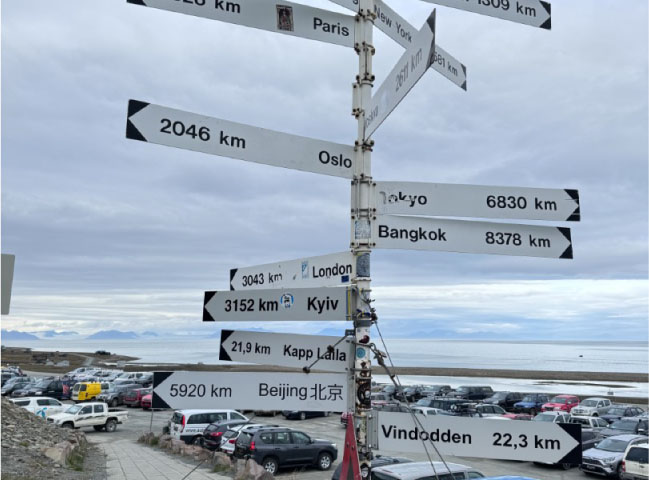
July 29, 2024 | Oslo, Norway
We arrived in Oslo for the start of our extraordinary Arctic journey. Given there was time to explore the city, some of us ventured to the Fram Museum, which tells the story of Norwegian polar exploration. Others visited Roald Amundsen's House in Uranienborg. The evening ended with a festive cocktail party, followed by dinner.
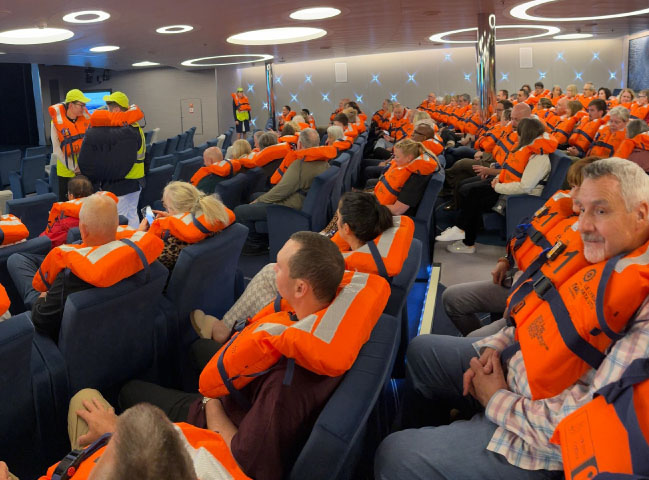
July 30, 2024 | Longyearbyen
We rose early for a morning charter flight to Longyearbyen, where we set out on a tour of the settlement before boarding lovely ‘Le Lyrial.’ After time to settle in, we met our Captain and crew and set sail for the Arctic wilderness en route to Ny-Ålesund on the Brøggerhalvøya, along the bay of Kongsfjorden.
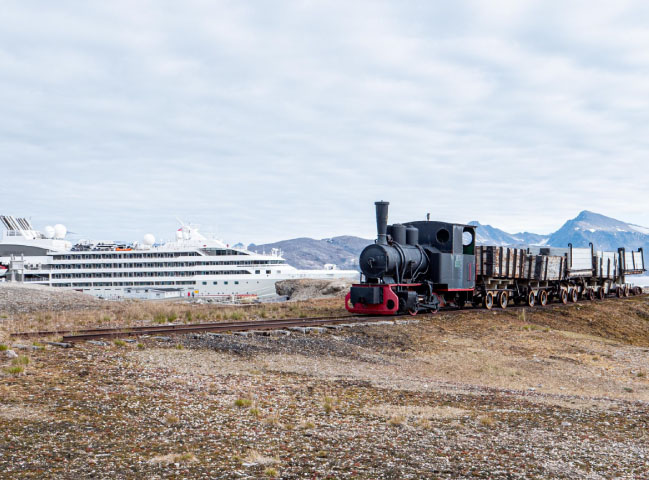
July 31, 2024 | Ny-Ålesund
We arrived on cue in the historically significant settlement of Ny-Ålesund. Peter Brandal and his coal mining company, Kings Bay Kull Compani AS, founded Ny-Ålesund in 1917.
On land, our ornithologists pointed out many bird species. After we sent postcards from the world’s northernmost post office, our historian discussed Salomon August Andrée’s
fateful balloon expedition, as well as the vaunted Norge dirigible flight by Amundsen/Ellsworth and Nobile. Our bear guards accompanied us as we viewed the airship mast. Located just outside the settlement's limits, the mast served as the launchpad for Roald Amundsen and Umberto Nobile’s pioneering North Pole expeditions.
The weather was beautiful, so coaxing guests back to the ship for an 11 a.m. departure was difficult. Over lunch, ‘Le Lyrial’ re-positioned. After an enlightening polar bear talk, we boarded our Zodiacs and cruised along the face of the Lilliehöökbreen glacier, observing icebergs, calvings, bearded seals and the most majestic landscape imaginable. As if this wasn’t enough, we later spotted a pod of belugas near the vessel. Our Captain positioned the ship for perfect views of these beautiful, gentle white whales. Ending the day, we attended a welcome cocktail party and dinner and met our ship’s senior officers.
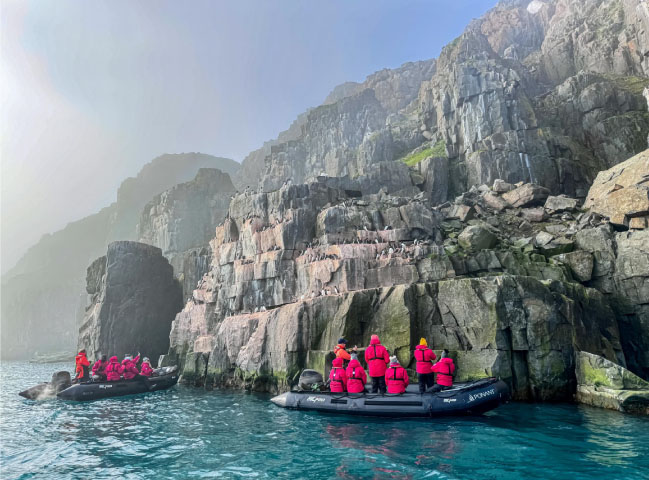
August 1, 2024 | Spitsbergen Archipelago
The day began with dense fog. Zodiacs were launched early, and we set out to the magnificent Alkefjellet, where countless of thick-billed murres breed on the basalt cliffs. Incubation of the unusually shaped eggs takes 30 days. Roughly 20 days later, the chicks launch themselves off the cliffs in a leap of faith toward the ocean below. The males exclusively feed the chicks for another eight weeks. Foraging upwards of 60 miles away, they dive as deep as 500 feet in search of sustenance. In a natural spectacle, birds were all about us — in the water, in the air and on the cliffs. Glaucous gulls were in attendance, feeding upon the murres.
Back aboard our vessel, we continued onward to Wahlbergøya. Weather conditions could not have been finer as we strolled through the tundra and watched a huge group of male walruses hauled out on the beach.
Returning to ‘Le Lyrial,’ our ornithologist discussed local seabirds. Then, our geologist offered an entertaining talk on the formation of sill cliffs. Rounding out a perfect day in the high Arctic, we cruised through exquisite icebergs and along a vast glacier.
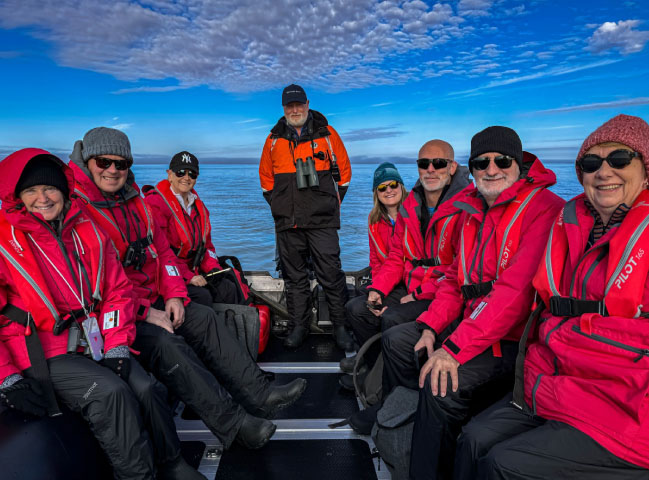
August 2, 2024 | Svalbard Archipelago
After a calm night at sea, we awoke to mirror-like water and sunny skies off remote Kvitoya (White Island). Scouts spotted two polar bears near our proposed landing site, by the monument to Salomon August Andrée's Arctic balloon expedition. Adjusting plans, we observed wildlife by Zodiac, seeing not only polar bears but also female walruses with calves.
Returning to our ship, we sailed on to Storøya, where thin strips of flat, ice-free land covered in pebbles offset a massive ice dome. As we glided on clean, perfectly calm water, walruses, Arctic terns, ducks and ice floes came into view.
Later, we enjoyed a calm evening onboard, some challenging themselves with a post-dinner round of trivia.
August 3, 2024 | Phippsøya
We woke to another day of calm seas and unusually warm weather. In the distance, the Sjuøyane archipelago emerged, beckoning us closer. Landing on Phippsøya, we marveled at its distinctive hat-shaped mountain, the lush carpet of mosses and scurvy grass, and the vibrant birdlife. Our resident botanist shared local knowledge, and our bear guards led walks across the tundra. We viewed Svalbard’s northernmost hut, a testament to Norwegian foresight. Built in 1936, it served as a lifeline for those caught in the unforgiving Arctic wilderness. We imagined how the humble structure — equipped with bunk beds, a wood stove and essential supplies — served as a haven during a raging Arctic storm.
The northernmost BBQ was held at lunchtime, at almost 81 degrees north. In glorious weather, we all enjoyed a festive meal on the pool deck. Then, James Balog’s Chasing Ice — a sobering documentary — was screened, revealing the realities of glacial recession, global warming and the commensurate consequences.
Shortly after lunch, we encountered much pack ice, covered with countless harp seals — an unusual gathering, even for our seasoned Expedition Team. For the remainder of the afternoon, we nosed our way gently through pack ice in search of ice bears. Sadly, they proved absent. Nonetheless, we enjoyed a beautifully illustrated lecture on these special creatures. It was a lovely afternoon looking out over sea ice as far as the eye could see.
A few hardy souls danced into the evening. Before bed, we turned our clocks back an hour, gaining an extra hour of sleep.

August 4, 2024 | At Sea En Route to Jan Mayen
It has been a day of tranquility and learning at sea. Our forensic ornithologist captivated us with insights into the birds of the Arctic. Naturalists were on hand to assist with bird identification, using binoculars and cameras, and to answer the myriad questions that arose. Our botanist then shared what life was like growing up in northern Norway, from the local customs to the Sami people and Norwegian folklore. Of course, Arctic cloudberries featured prominently. Some of us then attended an aerobics class, which involved a lot of jumping.
Later, our onboard geologist presented on the formation of the Atlantic Ocean, an engaging, visually arresting affair. Next, our storyteller shared insight into the North Pole expeditions of Fridtjof Nansen, Robert Peary and Frederick Cook.
As we continued onward, we tasted Norwegian delicacies, including preserved meats, pâté and cheese. Later, our photo coach demonstrated the versatile live photo feature of the iPhone, followed by a presentation on El Niño and the record-breaking heatwave of July 22, 2024 — the hottest day in 100,000 years. Given climate conditions, the increase in atmospheric carbon dioxide levels is concerningly high.
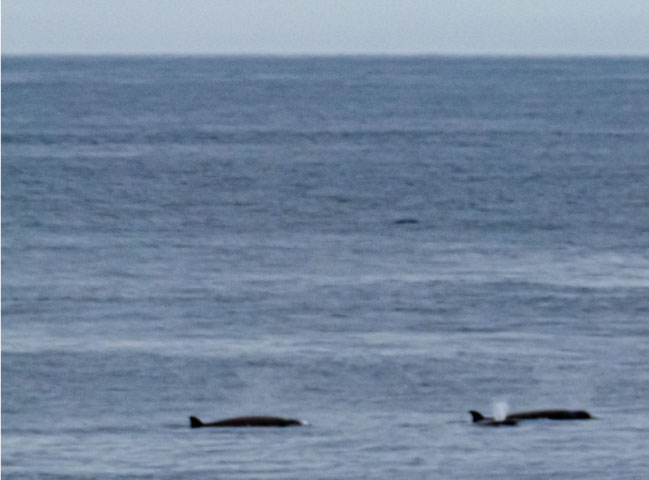
August 5, 2024 | At Sea En Route to Jan Mayen
We enjoyed a full, enriching day at sea, beginning with a talk on how flora adapts to the Arctic cold. Then, we attended an enlightening discussion on climate change in the Arctic, followed by a talk with our polar bear expert, who discussed the challenges of polar bear reproduction. Despite high cub mortality and dwindling habitat, a pair of polar bears may produce eight offspring within a decade. In contrast, two deer could produce 600 in the same timeframe. Polar bears nurture cubs for 2 ½ years, breeding only every three or four years, with fertility declining sharply after age 15. Canada's hunting regulations assume a 4% annual population increase, though it’s argued 2-3%, warning current quotas will drive polar bears to extinction. Two key breeding grounds in Svalbard have lost 90% of their denning sites in the past four decades, present quotas that will lead to polar bear extinction.
After a quick sighting of two fin whales, our ornithologist enthralled us with his on the marvels of migration, including Arctic terns. After dinner, we sat down to a jazz performance by our onboard musicians.
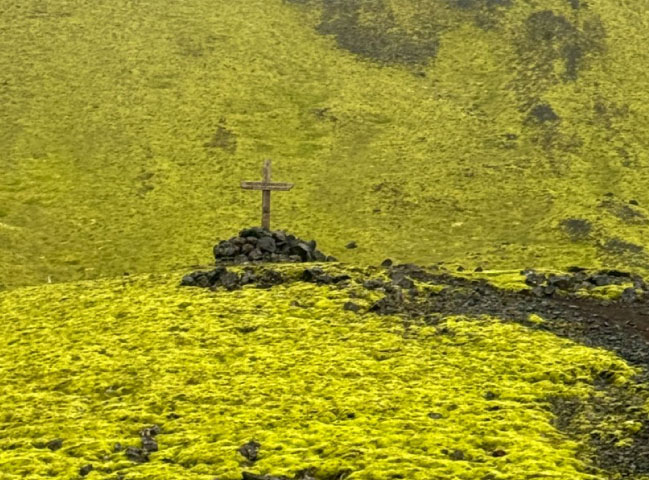
August 6, 2024 | Jan Mayen Island
To avoid time zone changes, we wisely stayed on Icelandic time. The morning was calm but foggy, with temporary clearings. We began the day’s enrichment by discussing nearby Greenland's unique time zones and the fact that it’s home to the world’s second-largest ice cap. Next came a talk on the great Norwegian polar explorer Roald Amundsen.
Before long, breathtaking views of Beerenberg came into view. The stratovolcano dominates the northeastern end of Jan Mayen, a remote Norwegian island named after Dutchman Jan Jacobs May of Schellinkhout, who first visited in 1614. These glacier-covered slopes soar 7,470 feet, creating an otherworldly backdrop. Our onboard photographer took a group photo, with Beerenberg’s near-symmetrical cone soaring in the background.
Cruising toward the afternoon’s landing site, ‘Le Lyrial’ proceeded along the western side of the spoon-shaped isthmus. Thankfully, despite fog and drizzle, we were able to land in good conditions. This isn’t possible about half the time.
Three hikes were offered, and many of us were delighted to stretch our legs. Others chose to explore the beach area, where whale bones, driftwood and vegetation lent interest. We also observed the memorial commemorating 10 whalers who perished there in 1634 while attempting to overwinter.
Due to persistent drizzle, most of us returned to the ship earlier than anticipated. After dinner, there was a lively, well-attended trivia night.
August 7, 2024 | Ittoqqortoomiit, Greenland
Last night, the ship encountered more rolling than usual during the ocean crossing from Jan Mayen to Scoresby Sound in Greenland. The day began with an enlightening presentation on our role as stewards of the planet, courtesy of our onboard geologist. Then, our botanist lent insight into the blooming tundra, including the adaptations necessary to survive under harsh conditions.
At the entrance to Scoresby Sound lies Ittoqqortoormiit (Scoresbysund), a small Danish settlement that’s home to around 500 indigenous people. Named after the English whaler William Scoresby, who first mapped the region in 1822, the town offers a glimpse into remote life. Home to one of the largest glacier systems on earth, it’s here that five large glaciers discharge their ice into a massive sound.
In the afternoon, we visited Ittoqqortoormiit, one of the most remote settlements in existence. After sending home postcards with Greenlandic stamps, we observed sled dogs and learned about life in this hunting and fishing village. A few large icebergs in the bay whet our appetite for more, which we thankfully saw about the ship during dinner.
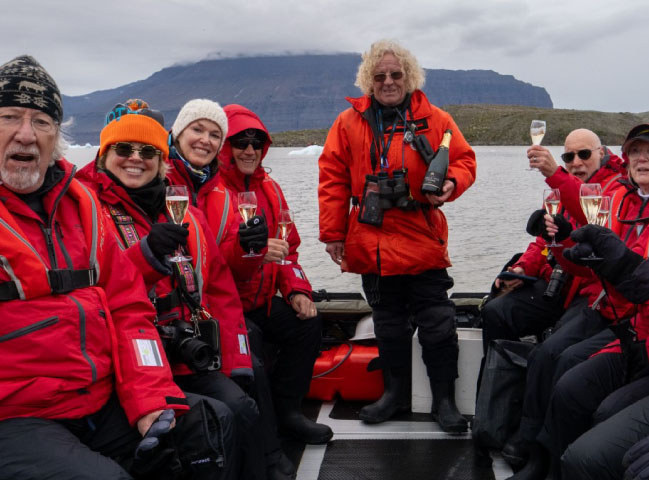
August 8, 2024 | Charcot Havn and Vikingebugt
We planned to disembark early today — until three polar bears were spotted on shore. We scrambled to view the sow and her two cubs from the outer decks, watching as they walked along the shore. About 30 minutes later, we boarded Zodiacs and landed at uninhabited Charcot Havn as intended.
Some of us set off on a long hike, with engaging insight from our botanist. Led by three bear guards, we spotted an Arctic fox. Others explored closer to the shore. Returning to ‘Le Lyrial’ we continued at a leisurely pace to Vikingebugt, the largest of a series of small inlets in the Scoresby Sound fjord system. Surrounded by the awe-inspiring grandeur of glaciers, mountains, tundra and icebergs, we were aware of our fortunate visit.
Volcanic basalt cooled here, creating stunning hexagonal patterns. These and other stunning geological formations created a breathtaking landscape. We cruised past cliffs in our Zodiacs; observed nesting terns and kittiwakes on a nearby island; and navigated through a field of icebergs. It was another fantastic day with A&K.
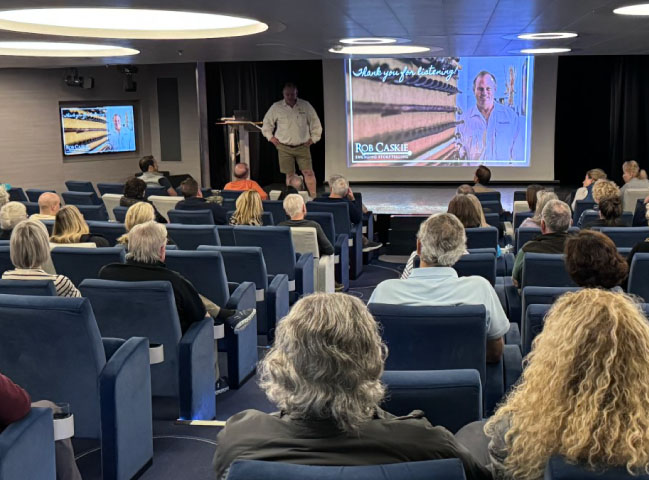
August 9, 2024 | At Sea En Route to Husavik, Iceland
The early morning hours were somewhat bumpy as we entered the open ocean, after the relative shelter of Scoresby Sound. A cold, low-salinity current, the East Greenland Current (EGC), flows southward along Greenland’s east coast, carrying Arctic ice into the North Atlantic. Ice export peaks from October to December, influenced by wind and temperature.
Thankfully the ocean calmed progressively as the day advanced, with the wind and sea coming from the stern of the ship.
Our day at sea was a rich blend of learning and relaxation, from energizing stretch and Zumba classes to a talk on drug discoveries in the polar seas; fascinating insight into the lives of John Franklin and John Rae; and a discussion on how birds are adapting to climate change. We then enjoyed a comprehensive overview of the flora encountered in Svalbard, Jan Mayen and Greenland and got a glimpse at the unique plant life awaiting us in Iceland.
This evening, we sipped cocktails alongside caviar and sat down to a post-dinner piano recital.
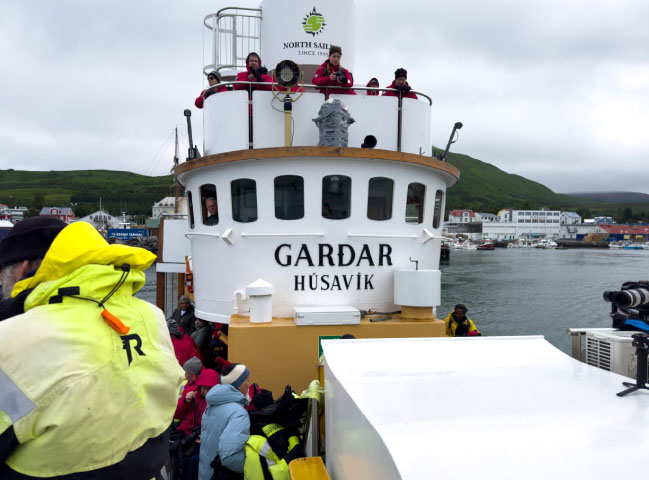
August 10, 2024 | Husavik, Iceland
‘Le Lyrial’ arrived promptly in Husavik in northern Iceland. This town, now home to 2,300 residents, was reputedly the first place settled in Iceland by a Norseman.
Today there were two excursions to choose from. Those who set off on a guided bus tour took in the richly varied landscape, with farms interspersed with vast lava fields and thermal vents. The highlight for many was a stop at Godafoss (Waterfall of the Gods). Iceland is renowned for its waterfalls and rivers, epitomized by this one. We passed pseudo craters, boiling mud pots, various ancient sheep breeds and yellow poles along each side of the road, indicating the local snow levels in autumn and winter.
Those who instead embarked on a whale-watching cruise experienced rather bumpy seas but were rewarded with sightings of humpback whales at close range.
Tonight, we bid adieu to our Captain during a farewell dinner and celebrated the remarkable crew who made our voyage unforgettable. As we enjoyed the camaraderie and shared stories, a bittersweet feeling washed over us, knowing our adventure was drawing to a close.
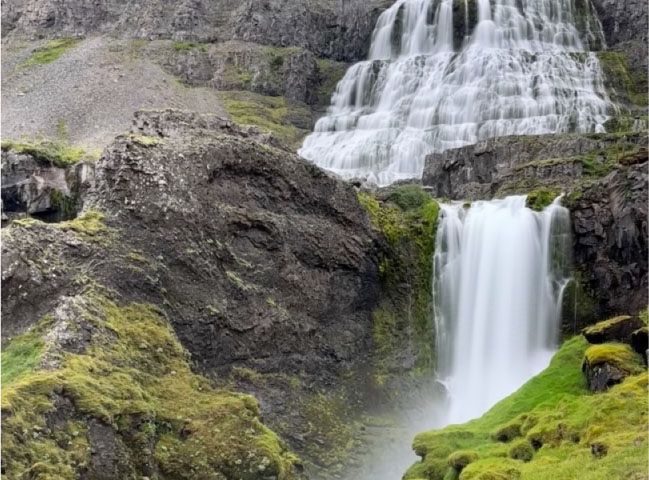
August 11, 2024 | Westfjords Region
Early this morning, on a perfectly calm ocean, ‘Le Lyrial’ cruised through the Westfjords region of Iceland, en route to the Dynjandi waterfall (Fjallfoss). The surrounding country was glorious — steep, green slopes plunging to the ocean and creating perfect reflections. As we approached the end of the fjord, Dynjandi could be seen plummeting 330 feet off the escarpment. Zodiacs ferried us ashore, and we all attempted the steep path toward the top of the waterfall,
alongside a crystal-clear river. The beauty was magnificent in every direction, while harbor seals and humpback whales added interest. Returning to our vessel by lunchtime, we continued onward to Reykjavik. Of course, we weren’t excited about returning our rental boots and life jackets, packing and disembarking in the morning.
To keep the mood lighthearted, we played a game of Liar’s Club, which involved choosing improbable words and having three contestants create imaginative stories about their possible meanings. The fourth contestant tells the truth. The audience then tries to guess who is lying and who is telling the truth. To say it was hilarious would be an understatement. We laughed until tears ran.
Reflecting on the voyage, it has been nothing short of extraordinary. We enjoyed perfect weather and followed our original itinerary without a change. After a pennant was auctioned benefitting the crew welfare fund, we enjoyed a captivating slideshow of our journey.
Sadly, tomorrow morning we fly home from Reykjavik, bringing with us memories that will last a lifetime.
 The Americas
The Americas Europe, Middle East and Africa
Europe, Middle East and Africa Australia, NZ and Asia
Australia, NZ and Asia



































































































































































































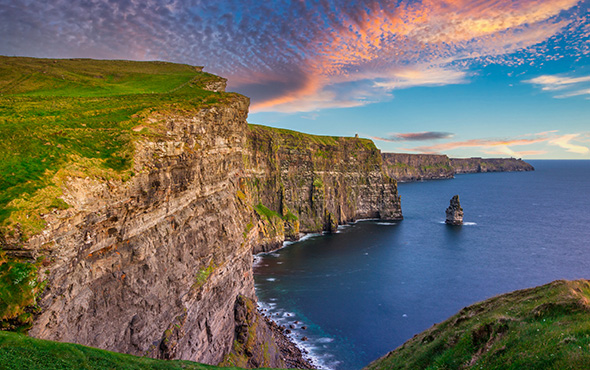




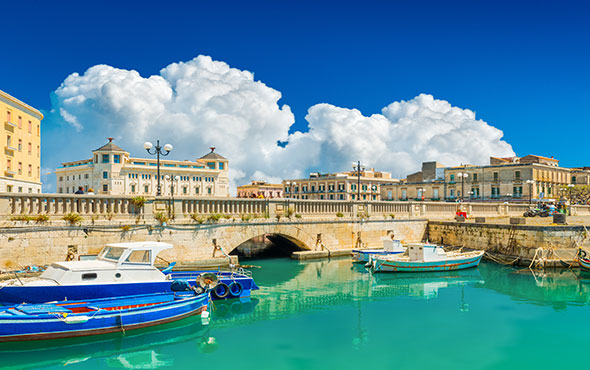



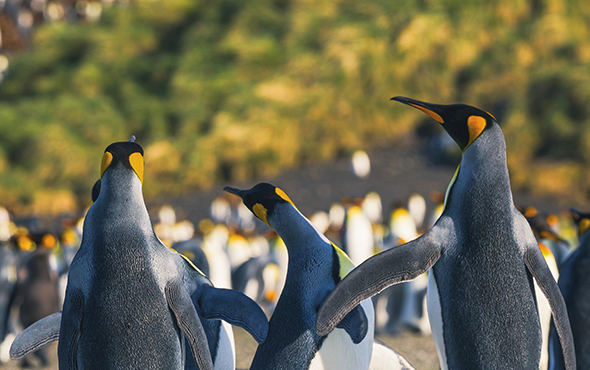
 The Americas
The Americas
 Europe, Middle East and Africa
Europe, Middle East and Africa Australia, NZ and Asia
Australia, NZ and Asia